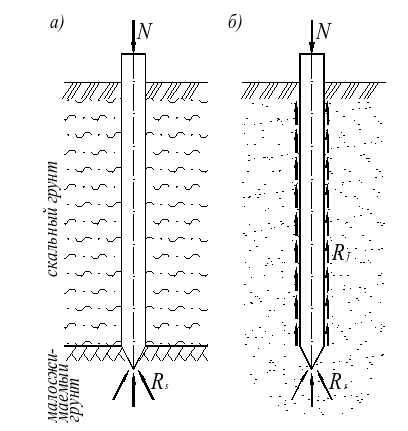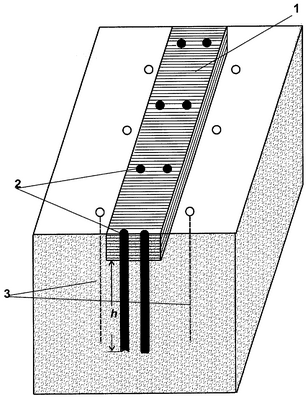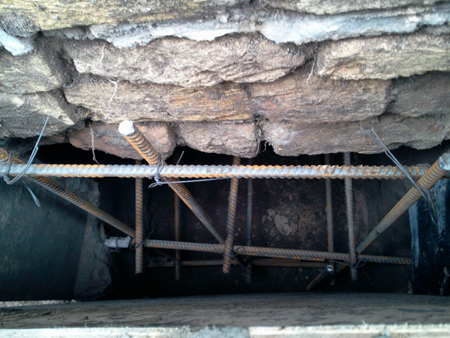Weak soils are a very big problem in construction. In order to secure and secure the entire structure, two basic technologies were developed with the use of piles:
- The first technology. Hanging piles are supports that are supported by a directly compressible primer.
- The second technology. Pile stand, this is a fairly long design that penetrates the weak layers and at least half a meter enters the hard layers of the soil.
In each of these technologies there are pluses and minuses, so considering the topic, we propose, without delving into the subtleties, to walk through the basic points.
Two technologies - two entities

Let's try to understand the problem of installation on weak grounds. The piles of the rack and the suspension bases, with all the external similarity, will differ according to the principle of action.
So:
- The pile-stand resembles a compressed rod, which transfers the entire load from the wearable mass to the low-compressible layers of the soil. In this case, in fact, in the redistribution of loads on the ground, it is the lower part of the structure, and not all of its body. In calculations it is necessary to pay attention to the strength of the soil, and it is precisely its ability to carry the mass of the structure, as well as the strength of the material from which the pile is made.
- Piles hanging very differently. In this case, piles are supported on directly compressible soils, and not on strong deep layers. Piles carry a load due to the friction of the entire body of products, and not just the point. And there is a significant disadvantage of this design.
Ways to solve the problem

To solve the problem of increasing the reliability of hanging piles, several technological developments have been developed and implemented, here are some of them:
- Increase the diameter of the piles, and in some cases, the length;
- Increase in "bushiness" of supports per unit area of the foundation of the building;
- Expansion of the heel of the product. In this case, the area of friction at the end of the product increases;
- Applications of modern technologies by the type of discharge-impulse.
However, practical application has shown not very bright prospect of such methods:
- First, any increase in the size of the product leads to a rise in the cost of the entire construction, since the price of the entire base consists of the prices for each element. In addition, it is worth remembering that the thicker the pile, the more difficult it is to poke into the ground;
- Secondly, the number of "driven" supports for such amplification can make the construction even more difficult in the direct sense and financially, but it does not bring the desired benefit:
- The bushy structure is subjected to a draft greater than one pile;
- The length of the standard support is 7 meters, while the sowing of a single pile and bush is approximately the same, but there is a paradox.

Interesting to know! There is amusing practical observation. If the distance between the piles is more than three diameters, the draft of the single support and the bush is approximately the same, as the distance decreases, the shrinkage of the basement increases sharply.
New technologies

Before new technologies, an insoluble problem appears at first glance, namely, an increase in the bearing capacity of existing pins. And this is on labile, weak soils. The purpose of this technique is to increase the frictional forces of the surface of the piles and the soil around them.
The instruction for applying the technology assumes the following order of action:
- In the existing foundation, in steps of 1.5 to 2 meters, they are drilled and pressurized to high pressure to form fracturing cavities. Drilling is performed in interswith space and at the base of installed piles;
For your information! Under the influence of high pressure, the soil is compacted near the existing bases, to achieve the maximum result, drilling is carried out to a depth of two to one-half of the level of the underlying piles. In addition to the usual direction of filling with a fast-hardening mortar, multidirectional injectors are used, which allow the soil to be ground under the already established structures.

- In existing buildings, with a plate foundation, the injectors are inserted throughout the tiled field with the capture of squares from one and a half to one and a half meters, to two by three meters. All operations take place in the basement;
- The solution is pumped in stages, ideal is the filling of the mines that go and adjoin each other. Thus, there is a purposeful displacement of the soils to a specific support and the support of this newly formed cushion with original reinforcing belts from the cement mixture.
The positive characteristics of this method are:
- Sealing of soil with reinforcement elements takes place without complex earthworks, the use of heavy equipment and additional construction crews;
- Blowing the cement mixture under pressure allows increasing the frictional force between the compacted soils and the surface of the native piles, which in turn will increase the efficiency of the load-bearing capacity of the structure by 2 times;
- The proposed technology will allow to repair the foundations of an existing building and strengthen the capabilities of suspension pylons. Since the classical technology involves the erection of new piles and the redistribution of the load on them, which is practically not realistic, in the new technique this inconvenience is leveled.
When constructing foundations on weak soils, piles of different types are used. They differ in the material of manufacture, the method of immersion, the size and shape of the cross-section. According to the method of interaction with soil layers, such structures belong to one of two groups - pendant piles or posts.
In the first case, the posts do not rest on a solid base, but on compressible grounds, transferring loads to the side surfaces and the tip. The second group of piles is held by small or incompressible soils, which take the effort from the point or extended heel of foundation trunks. With this interaction, the forces of soil resistance on the side walls of foundation supports in calculating their bearing capacity are not taken into account.
Types and features of piles
By the method of installation in the design position, both hanging and pile racks are divided into:- driven;
- pressed;
- printed;
- drilling;
- screw.
They are concrete and reinforced concrete, metal and wooden, hollow and solid. The hanging pile does not rest on the supporting soil layer, as the foundation pillars-racks, and this is its main drawback. In order to increase the reliability of the "unsecure" foundation, several methods are used:
- an increase in the cross-sectional area or the length of the pile pillar;
- adding the number of piles per unit area;
- the device of camouflage broadening of the heel.
But these methods do not always justify themselves. For example, an increase in size always leads to additional material investments, an increase in the labor intensity of work, and the need to order more powerful and expensive equipment. The use of additional piles in the bushes can lead to the opposite effect, as the weighting of the structure will pull a larger draft of the structure. By the way, a reduction in the pitch between the point supports leads to the same result. But in some situations, the increase in bushiness saves the situation and is more suitable than the installation pile racks.

The widened heel is advantageous in that it becomes possible to further support the hanging barrel on the ground. However, for the driven pile, in this case, there are inconveniences. The technology does not allow it to be submerged.
Uneven foundations of the foundation entail the appearance of cracks on the walls of the building and its possible destruction.
The length of the suspended piles is determined depending on the design load of the structure and the "weakness" of the soils lying on the site. The larger the first component and the smaller the second, the deeper the pile supports are installed. In some cases, they are made composite.
Piles of the rack rest on a strong layer of soil, transferring to it loads from the ground part of the structure. Often they are heated some distance deep, which increases the reliability of the foundation and prevents any precipitation. The length of the trunks can be 20 m or more.
Calculation of a hanging driven pile
Bearing capacity (F d, kN) of hanging, as well as pile shells, is determined by the formula specified in the corresponding section of SNiP 2.02.03-85. The calculation is based on several real indicators. These include:
- u -the perimeter of the section of the driven support in meters;
- A -the area of the pile pillar, shell, or the largest section of camouflage broadening in square meters;
- H i -the thickness of each of the soil layers located in the immediate vicinity of the lateral surfaces of the driven pile support, in meters.
The calculation includes the table values:
- R- calculated value of the resistance of the ground layer located below the bottom of the pile in kPa (Table 1);
- Fi - calculated values of the resistance of each of the soil layers in contact with the lateral surface of the foundation support, in kPa (Table 2);
- Y c = 1 - coefficient determining the working conditions of the structure;
- Y cr - the same, under the tip of the pile (Table 3);
- Y cf - the same, on the lateral surface, taking into account the method of penetration of the support (Table 3).

The calculation itself for the compressive load is carried out according to the formula:
F d = Yc * (Ycr * R * A + u * Σ Ycf * Fi * Hi).
, having inclined lateral faces, are calculated by a slightly different formula, in which the magnitude of the slope and the different values of the areas of the section of the foundation column are taken into account.
Another calculation of the bearing capacity of the driven pile and the shell, which does not involve excavation, is performed on the pulling load. The designations here are the same as in the previous formula, however the coefficient of working conditions ( Yc) has other indicators. When the support is buried to 4 meters, it equals 0.6, and more than 4 meters - 0.8. It should be noted that these values do not relate to the foundation under the power line support. The formula for the calculation is as follows:
F du = Yc * u * Σ Ycf * Fi * Hi
Printed and drilled types of suspended piles are calculated using the same formulas, but taking into account the conditions of the well construction and the concreting of the barrel, which affect the coefficient γ cf. It is determined from Table 5 of the same SNiP. The norm describes some other features of the calculation.
Piles of rack
Their carrying capacity is determined by the simplified formula:
F d = Yc * R * A.
The letters here correspond to the previously described ones. The only difference is that the value of R, which determines the resistance of the soil under the lower part of the pile of the column, is not taken according to the tables, but is calculated by the formulas.
Unstable soil is a common problem that many builders encounter when building a foundation. To obtain a reliable base, piles are used on weak ground. Their length compensates for the lack of support, and the frictional forces of the side surfaces on the ground help to hold in the soil. Depending on the nature of the layer and the way it interacts with subsoil stratification, hanging piles and piles of the struts are distinguished.
The difference between pendant and pile racks
The first category includes supports that rely on compressible soils. Their structure allows the lower end and lateral surface to redirect the load to the soil base.
The second category includes supports supported by slightly compressible soils, which include clayey and coarse clastic rocks with a dense sandy aggregate.
Hanging piles and piles of the rack have a similar structure and appearance, but are fundamentally different in the principle of operation and basic technologies to ensure the security of the future structure.
Hanging constructions are used in working with strong layers of soil, lying at great depth. The task of such supports is to pass through the thickness of weak soil and to fix the lower end in a firm ground layer. Achieving this goal is possible only with the correct calculation of the length of the suspended pile, which takes into account the following indicators:
- The density of the material from which it is composed.
- Working length.
- Characteristics of soil characteristics: mobility, looseness, saturation with moisture.
- The design load of the future construction: the greater its value, the deeper the pendant pile must be installed.
The principle of the pile rack
 The principle of the pile rack
The principle of the pile rack
The pile is a structure up to 20 m long, which passes through unstable layers of soil and is fixed in a hard surface at a depth of 0.5 meters or more. Unlike hanging, this support prevents the gradual draft of the building, exerting a load on the solid ground not with the whole body, but at the expense of the lower part. Piles of the rack are widely used for laying pipelines and in large-scale industrial construction. Such supports can also be used in areas with unpredictable seismic activity.
To calculate the optimal length of piles, the racks are oriented to the following parameters:
- strength of the ground;
- the ability of a solid base to carry a mass of future construction;
- pile manufacturing material of the rack.
Advantages and disadvantages of supporting structures
Depending on the material of manufacture, wood, concrete, reinforced concrete, metal, solid, and hollow products are distinguished. An important criterion for selection is the method of installation, which divides the supports into driven, drilled, pressed, screwed and stuffed.
Fundamental pole piles are considered more reliable than pendant piles that do not rest on the carrier layer of the ground.
You can eliminate this significant shortcoming in several ways:
- Increased cross-sectional area.
- Increase in length.
- Extension of diameter.
- Adding more supports to one unit of area.
However, such methods do not justify themselves in terms of economy and practicality.
Thus, increasing the size of the product due to changes in cross-sectional area, length and diameter leads to additional costs of money and energy: the purchase of additional large-sized hoisting equipment, the cost of related construction materials, the hiring of skilled workers, the general appreciation of the basement, the price of which is made up of the cost of each element.
The unreasonable use of additional supports greatly complicates the construction and leads to the draft of the structure. In turn, the uneven subsidence of the foundation entails unpleasant consequences, which begin with the appearance of cracks on the walls and result in the destruction of the structure.
Thus, strengthening the foundation is a laborious process that requires certain professional skills and the availability of special equipment. The choice of supporting products is based on the initial requirements and technical and economic comparison.
